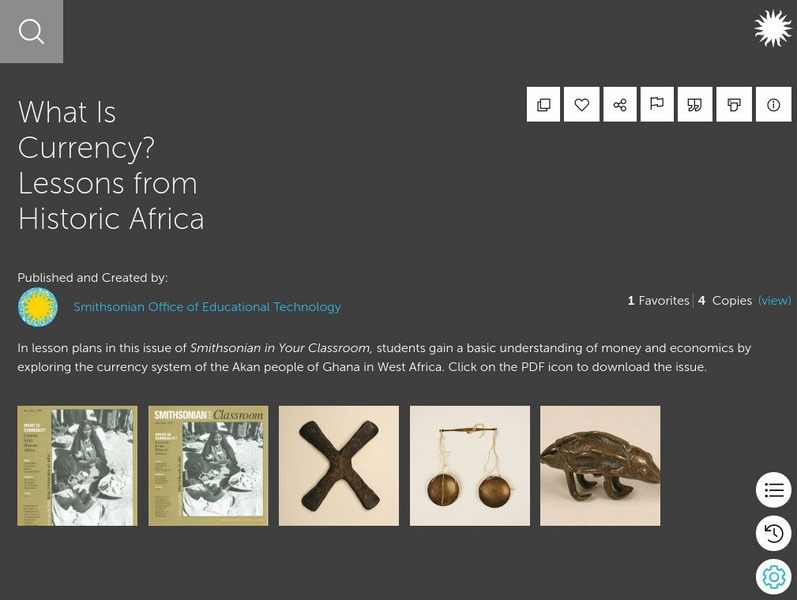Curated OER
The Secret Life of Money Part 1
Students explore money, how its value determined, and how mere slips of paper or coins, and in today's high-tech world electronic blips, represent the wealth of a nation.
Curated OER
Markets of Africa
Students identify one advantage and one disadvantage to open air markets in Africa. students create a mural on paper to be hung on the classroom wall. Small groups make a stand of something that would be sold at an open air market.
Curated OER
Pioneer Currency in Utah: Have you got change for 5?
Eleventh graders examine why pioneer society needed a uniform medium of exchange -- not so much among themselves, but for use with non-Mormon suppliers and California immigrants.
Curated OER
Pocumtucks In Deerfield
Students read a story about the Pocumtucks' religious beliefs. Using the text, they discover their concept of land ownership and how they migrated within their territory in different seasons. They use primary and secondary sources to...
Better Lesson
Better Lesson: Want to Trade?
Students will write about what they would trade for gold and practice inventive spelling in the process. After reading "In 1492", students will discuss how Christopher Columbus traded with the natives and then write what they would trade...
Council for Economic Education
Econ Ed Link: Lewis and Clark Barter With Native Americans
In this lesson you will define the term barter and give examples of bartering in several different areas. Find out how this system took shape and was useful to Lewis and Clark. This site is extremely informative and contains extension...
Council for Economic Education
Econ Ed Link: Hawaiian Economics: Barter for Fish & Poi
Use this lesson to learn more about the Hawaiian economics system. Learn how they developed and used this specialized type of money system. "In this lesson, you will learn how specialization and division of labor increased productivity...
Middlebury College
Middlebury College: Trade and Barter in Ancient Greece
Middlebury College provides an essay that uses ancient Greek mythology to explain how the Greeks viewed economic practices like trading and bartering.
Council for Economic Education
Econ Ed Link: Trade to the Tailor: Student Version
Students can use this site online in conjuction with the teacher's lesson plan, "Trade to the Tailor."
Council for Economic Education
Econ Ed Link: Hawaiian Economics: Barter for Fish & Poi
In ancient Hawaii, chiefs managed the economy by creating a land division system, the Ahupua'a, which divided the islands into pie slice shapes. Each Ahupua'a covered the three main regions of the islands: the mountains, the valleys, and...
The Franklin Institute
Franklin Institute: Bartering for Goods
The Franklin Institute Online explains what bartering is and how it developed down through history. A lesson plan and quiz are also provided.
Education.com
Education.com: Goods and Services: Let's Make a Deal!
[Free Registration/Login Required] Have your students experience the act of trading goods and services with bartering. In this activity, students will have the opportunity to make a deal, in order to get what they want. Better yet, make...
Edutopia
Edutopia: Goods and Services [Pdf]
A unit that teaches the difference between goods and services, the difference between producers and consumers, the difference between human, natural, and capital resources, and the difference between bartering/trading and buying/selling....
Federal Reserve Bank
Federal Reserve Bank of Philadelphia: Why Money? [Pdf]
Young scholars learn about barter, and the benefits of using money, as they participate in this trading simulation.
Smithsonian Institution
Smithsonian Learning Lab: What Is Currency? Lessons From Historic Africa
From the Smithsonian, this site offers lessons and resources on currency, its use (in the form of gold dust, salt, or metal objects) as an instrument of trade in historic Africa, and its requirements as an instrument of trade in the...
Council for Economic Education
Econ Ed Link: Bill, Are You Bogus?
In a barter system, people have to trade goods and services for other goods and services. In an economy that produces millions of goods and services, barter is very difficult. Think of all the stuff (goods and services) you have.
Council for Economic Education
Econ Ed Link: I Have No Money, Would You Take Wampum?
Through the use of folk tales, history, and the students' own experiences, students will recognize the inter-relatedness of goods, services, money. They will locate information about barter as a means of trade, use folk tales as an...
Council for Economic Education
Econ Ed Link: Pennies Make Cents
Students will review the history of trade before money and will investigate the history of money. Students will locate information about the first coin authorized by the United States and will learn about the penny.
University of Nebraska Omaha
Ec Ed Web: Virtual Economics Web Companion
The Virtual Economics Web Companion for K-12 economics and social studies teachers was created by the National Council on Economic Education. A wide variety of educational materials and lesson plans can be accessed through this site....
TED Talks
Ted: Ted Ed: What Is a Gift Economy?
What if, this holiday season, instead of saying "thank you" to your aunt for her gift of a knitted sweater, the polite response expected from you was to show up at her house in a week with a better gift? Or to vote for her in the town...










![Federal Reserve Bank of Philadelphia: Why Money? [Pdf] Lesson Plan Federal Reserve Bank of Philadelphia: Why Money? [Pdf] Lesson Plan](http://content.lessonplanet.com/resources/thumbnails/409976/large/bwluav9tywdpy2symdiwmduymc0xmdm5ny0xdnbua3j3lmpwzw.jpg?1589982798)



